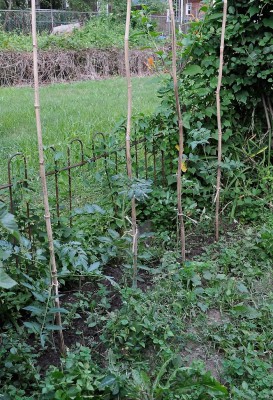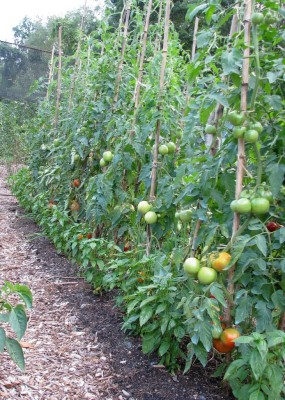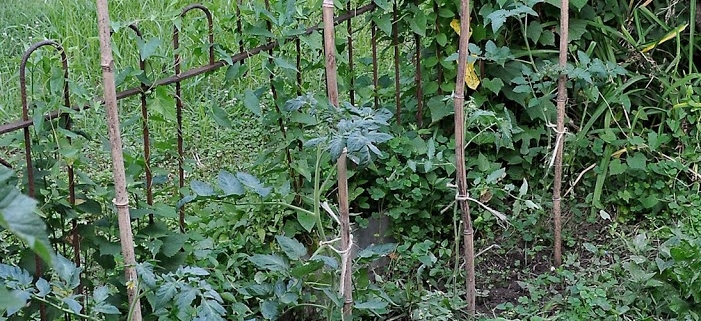[Tomatoes for G, Healthy tomatoes, Pea problems]
My daughter Genevieve does not like to garden but does like good-tasting vegetables, especially tomatoes. So when she recently moved to the third floor of a rented house with access to some backyard space, I, of course, offered her some special tomato plants and help in planting them. No, this wasn’t necessarily going to be a garden, but 9 tomato plants bearing fruits of minimal labor.
The plants — the varieties Anna Russian, Amish Paste, Sungold, Carmello, and Valencia — went into the ground at the end of May. I brought along, besides the 9 plants, some building paper (“rosin paper”), bamboo stakes, a small sledge hammer, compost, and soybean meal (for nitrogen fertilizer).

To plant, we first knocked down some of the existing weeds sprouting along the south border of the narrow, thankfully sunny, city yard. A sprinkling of soybean meal at each planting site was topped with an 18 inch by 18 inch square of the paper slit to its center, into which we cut a planting hole just big enough to accommodate a plant’s root ball. Each plant went into a root-ball-sized hole poked into the ground beneath the opening in the paper. We covered each paper square with an inch or so of compost, hammered a bamboo stake into the ground next to each plant, and the tomato planting was complete.
Genevieve’s job was to water the plants for a few days to get them established, to keep the plants to a single stem by pruning off suckers, and to tie the plants to the stakes, as needed.
I’ve started whole gardens with a more refined version of this paper/compost method, so this week’s visit to the “garden,” possibly Philadelphia’s most low-maintenance “garden,” brought no surprises. The plants were growing and tomatoes were on their way. I couldn’t restrain myself from whacking back weeds that had grown up beyond the paper barriers to shade some of the plants. I stopped my whacking every few minutes to move the end of a hose from one plant to the next to thoroughly soak the ground beneath each plant.
Great-tasting tomatoes are scheduled to begin about the third week in July.
************************************************
Tomato plants in my own garden also require little care from me now, basically nothing more than periodic tying to their stakes and occasional weeding.

In contrast to last year’s summer of late blight, plants this year look lusty and fruitful. Late blight has already been reported this year in isolated pockets in in Connecticut, Pennsylvania, and Michigan, and on Long Island. My plant’s healthy look comes from a thorough cleanup and composting of diseased residues last year, moving this year’s tomatoes to a new location in the garden, and starting my own planting from seed. All these measures also go a long way to thwarting the other leaf spot diseases (septoria leaf spot and early blight) that more commonly attack tomatoes around here.
The hot, sunny weather also helps a lot, ultraviolet rays and heat stopping late blight dead in its tracks.
**************************************************
Back in March I wrote of my pea problems. In brief, every year for the past few years, my peas have begun bearing pods and then too soon afterwards have begun to yellow and die. I thought I narrowed down the cause to one or two root diseases of peas, fusarium and aphanomyces, both of which live for a long, long time in the soil, making crop rotation of limited utility in their control.
To keep these diseases in check, I planted the fusarium resistant variety Little Marvel and, because aphanomyces likes wet soil, kept the pea beds on the dry side. I also made one planting in an area that’s never been home to peas.
The only peas still thriving are the ones planted in a previously pea-less home. Pulling up yellowing vines from the other beds did not, unfortunately, yield tell tale symptoms of few branch roots (aphanomyces) or reddish roots (fusarium), so I’m still in a quandary.




Dear Dr. Reich;
I’m happy to see your tomato plants, and know that my plants are not unusual with their 5′ height. True, tomatoes appear to be doing very well this year. I, too, grew from seed indoors, and rotated the planting. Thanks for all your fabulous gardening information!
Do keep us posted if you find the answer to the early pea dieback. I’v been having the same problem.